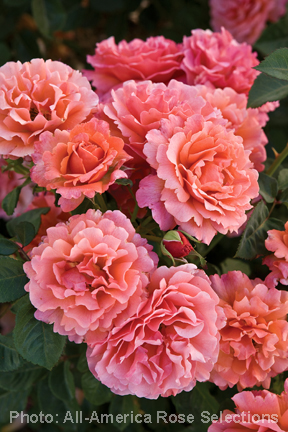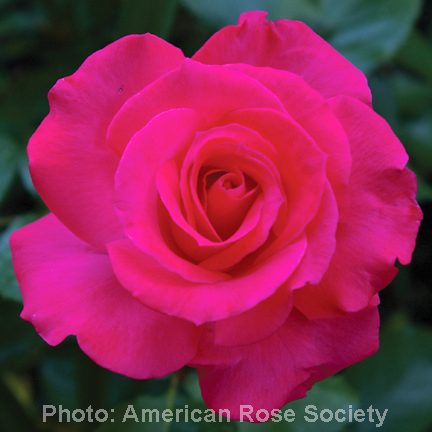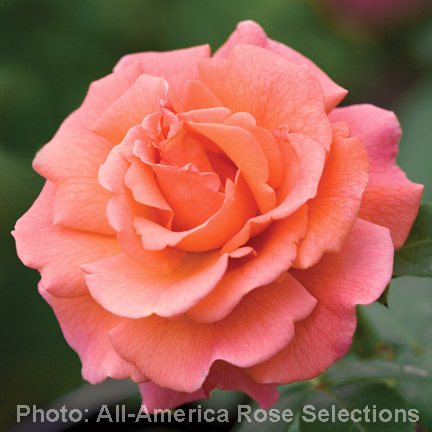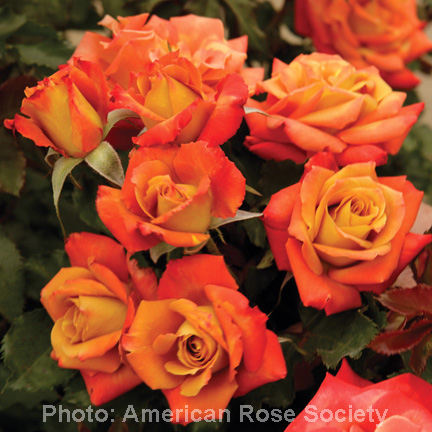
Gorgeous as ever.
That should come as no surprise with the new roses offered for 2010. Whether from societies that test roses or from big vendors like Jackson & Perkins or David Austin Roses, the latest roses are once again mouth-watering eye candy, seemingly perfect in every way.
But the real work begins when you bring those roses home. It’s one thing to covet professionally grown roses and their professional head shots. It may be quite another to keep them looking picture-perfect in the garden.
Start Now
Winter is ordinarily the season for roses to go dormant. On the Central Coast, that may not always be evident, especially in a year like this, when our current, warm daytime temperatures keep boosting occasional blooms. Indeed, in my garden, a butter yellow Graham Thomas is currently bearing both its usual plump, red-speckled rose hips as well as half a dozen fresh flowers.
Nonetheless, this is the time to at least pretend that our roses are dormant. Otherwise, by next summer, the bushes are destined to be prickly patches of leggy, criss-crossing branches and few flowers. They may also become more inviting to pests and diseases.
Start with a good set of hand pruners, loppers and heavy gloves.
If your roses are still covered in leaves or are bearing a few rogue flowers, strip those first.
Remove any canes that are old, fat, fissured, gray and covered with nasty thorns. Cut off any younger canes that cross back through the middle of the bush.

Take a look at what’s left. If you’re pruning a hybrid tea, keep pruning until you have three to five canes that all bend away from the crown to form an upright, vase-like shape. Cut off their tops, so that you end up with 18 to 36 inches of stem. Cut them all to the same height, and you’ll have uniform growth this spring. However, I like to vary the heights for a more natural look.
If you’re pruning a shrub rose, leave a few more canes, again with an eye toward creating that open crown. But cut the stems a little shorter, leaving 18 to 24 inches of each.
Climbing roses don’t require as severe pruning. However, they bloom best if you trim them back to their horizontal branches.
Regardless of the type of rose, make your cuts at an angle, below outward-facing buds. New growth will sprout in the same, outward direction, leaving a more open center. Encouraging sunlight to reach down to the crown stimulates dormant buds, which will eventually result in more prolific flowering.
Next, rake clean your clippings, as well as any remnants of last year’s leaves or detritus. It’s important to scrape down to soil level to remove any pests or pathogens that are inclined to overwinter in the litter.
Pull any emerging weeds. Reshape your watering basins. Fill the basins with fresh, organic mulch. Then fertilize with a slow-release, organic fertilizer containing fish, cottonseed, alfalfa, bone or kelp meal. Don’t apply anything heavily tilted toward nitrogen now. Too much early green growth can promote an early flush of aphids, not flowers.
Also deep water your roses this time of year, to mimic nourishing rains.

New Roses
If you’re buying bare-root roses now, inspect their roots, which should radiate evenly from the stem and have some flex. Avoid any roses that bear shriveled or brittle roots.
Plant your new roses the instant you get them home. Or submerge their roots in a bucket of water overnight, if you’re going to plant them the next day. If you can’t plant until a few days beyond that, keep the loose material that the roots came wrapped in moist, or bury the roots in moist sand or sawdust in the shade.
Location is key. Most roses need at least six hours of direct sunlight each day during the growing season, although they can tolerate less light over winter.
Air circulation is important for preventing such persistent diseases as powdery mildew. Avoid cramming your roses into tight spaces, or planting them too close together. Hybrid teas tend to grow 2 to 3 feet wide; shrub roses typically spread 3 to 4 feet wide; and ground cover roses can easily span 6 feet.
At planting time, dig a hole 2 1/2 to 3 feet deep and wide. Break up the soil, discard any rocks or unworkable clods, and mix the remains with garden compost, aged manure or packaged soil amendment at a rate of 1/3rd amendment to 2/3rds existing soil.
Fill the bottom foot of the hole with the amended soil, toss in a handful of bone meal or super phosphate and work it in lightly. Add more amended soil to form a cone in the center of the hole. Place the bare-root rose on the cone, spreading out the roots. Adjust the height so the crown, or place where the roots meet the stem, is 2 inches above the soil line.
Fill the hole with the remaining amended soil. Don’t stomp on it, which might damage the new roots.
As with your existing roses, form a watering basin after planting. Spread mulch inside the basin as well. However, instead of applying the mulch only below the bush, pour more up and over the crown. Deep soak the plants every week or so, unless winter rains oblige. When new growth appears in spring, brush off the extra mulch.

Award Winners for 2010
If you’re not sure where to start with buying a new rose, look for any awards that it might have received from an independent group (rather than from the vendor).
All-America Rose Selections has been evaluating roses in test gardens across the United States for some 70 years.
Easy Does It is the only AARS winner for 2010. A floribunda, it’s been bred to resist disease. It forms a rounded, bushy mound covered in medium-large double, ruffled flowers in shades of coral, peach and apricot.
The American Rose Society has been recognizing new miniature and Mini-Flora rose varieties for 36 years, and bestowed four awards of excellence for 2010.

First and Foremost is a Mini-Flora that bears long-lasting, deep pink flowers on bushes up to 2 1/2 feet tall and wide.
Daddy Frank is a disease-resistant Mini-Flora that blooms in deep red on bushes that grow 3 feet tall.
Magic Show is a miniature rose that bears dainty flowers in a blend of red and white. It grows up to 2 feet tall and is a quick rebloomer.
Spirit Dance is a Mini-Flora that bears multi-hued flowers that begin as long, pointed buds in yellow, then turn to orange and deep red as they age.
Seeds of Wisdom
Tear off sucker growth at the base of your roses by hand. If you use clippers, scrape the open wood afterward. Injuring the growth buds will reduce the number of future shoots.
≈
Copyright, Joan S. Bolton. All rights reserved. Reproduction of text or photos in any form is prohibited without written permission.
≈
